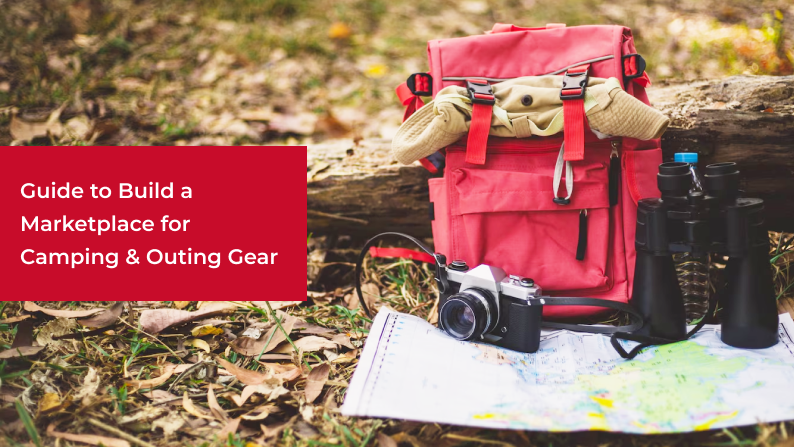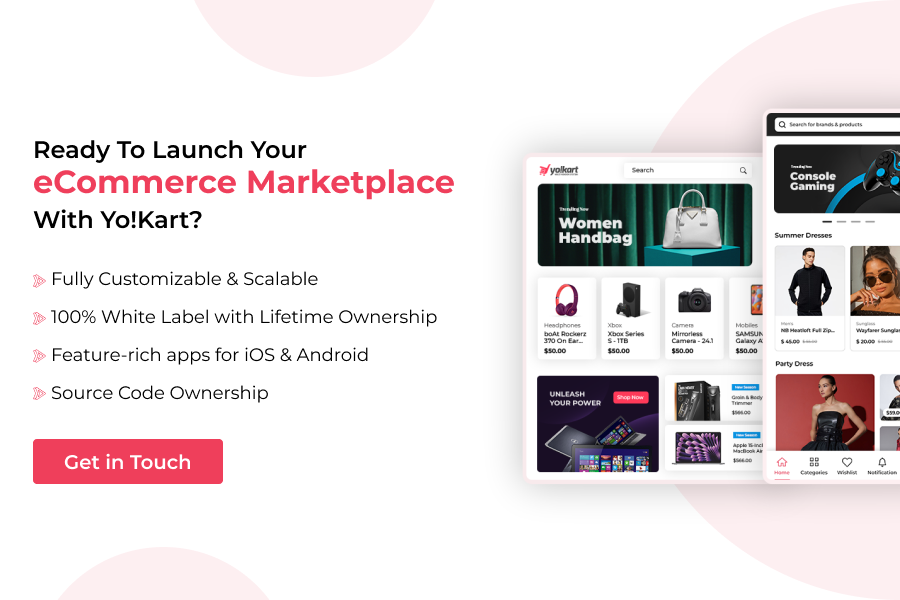Camping, hiking, and outdoor exploration have become much more than weekend hobbies; they represent a growing lifestyle trend driven by a desire for sustainability, wellness, and adventure. In the past few years, the global camping and outdoor gear industry has seen explosive growth as more people seek escape in nature while expecting the convenience of digital shopping.
According to Statista, the market volume of the global camping market is projected to reach $77.93 billion by 2030, growing at a CAGR of 9.46% from 2025 to 2030. Thus, the increasing popularity of glamping (luxury camping), eco-tourism, and digital nomad culture has created enormous opportunities for entrepreneurs.
If you are an entrepreneur ready to enter this proliferating industry, then one of the most profitable business models is building a marketplace for camping and outing gear.
Furthermore, this guide will provide you with an expert roadmap to build a marketplace for Camping & Outing gear, detailing the critical features, business models, and strategic development choices.
Table of Contents
- What is a Camping & Outing Gear Marketplace?
- Top Marketplaces Selling Camping & Outing Gears
- Must-Have Features in a Profitable Camping & Outing Gear Marketplace
- Types of Gear Selling Marketplaces
- Steps to Build a Marketplace for Camping & Gear
- Factors Affecting the Cost to Build a Camping & Gear Marketplace
- How Yo!Kart Can Help Build Your Camping & Gear Marketplace
- Conclusion
What is a Camping & Outing Gear Marketplace?
A camping and outing gear marketplace is an eCommerce platform that connects outdoor gear vendors with consumers. It is a centralized online platform that functions as a multi-seller ecosystem where brands, retailers, and independent sellers list their gear, such as tents, hiking gear, travel accessories, and outdoor clothing while customers browse, compare, and buy products.
To simplify, you can think of it as a niche version of Amazon designed specifically for outdoor enthusiasts.
Core Stakeholders of the Marketplace
- Admin or Marketplace Owner: Manages operations, sets commission rates, approves sellers, and oversees platform policies.
- Vendors or Sellers: Register to list their camping and outing gear, lanterns, cooking equipment, etc.
- Buyers or Customers: Purchase items, leave reviews, and engage with multiple sellers through one account.
This structure benefits everyone involved:
- Admin/s earn steady revenue from commissions and premium listings.
- Sellers get exposure to a wider audience without needing their own website.
- Buyers enjoy convenience, variety, and trust.
Now that you are clear about what a marketplace for camping and outing gear is, let’s have a look at some of the top marketplaces in this industry.
Top Marketplaces Selling Camping & Outing Gears
To build a marketplace for Camping & Outing gear that can compete, it’s essential to analyze the strengths of established players:
| Marketplace Model | Focus / Key Differentiator | Target Audience |
| REI Co-op | Product & Community: Mixes its own high-quality private-label goods with third-party brands. Strong focus on sustainability, member loyalty, and educational content. | Eco-conscious consumers, outdoor enthusiasts, and co-op members. |
| Backcountry | Specialization & Expertise: Deep focus on specific technical gear (ski, snowboard, cycling, climbing). Known for highly knowledgeable customer service (“Gearheads”). | Serious adventurers, experienced hikers, and technical sport participants. |
| Amazon / Walmart | Scale & Convenience: Offers a vast inventory and logistics, but lacks the specialized filtering, expert advice, and niche brand curation of focused competitors. | General consumers, budget shoppers, impulse buyers. |
| GearTrade / eBay | C2C (Consumer-to-Consumer): Focuses on new and used gear trading. Appeals to budget-minded or sustainable shoppers looking for second-hand equipment. | Sustainable consumers, those seeking specialized vintage or discontinued gear. |
Must-Have Features in a Profitable Camping & Outing Gear Marketplace
When planning your marketplace, features are not just “nice-to-haves”; they are critical for building trust, enhancing usability, and driving sales. Moreover, a well-designed platform ensures that buyers can find what they need quickly, feel confident in their purchases, and return for future shopping. Hence, given below are some of the must-have features for a successful camping and outing gear marketplace:
1. Seamless Vendor Onboarding
A simple signup and approval process encourages sellers to join. Thus, your platform should allow easy product uploads, inventory management, and automated commission handling.
2. Advanced Search and Smart Filters
Outdoor gear buyers often search for specifics, such as: “3-person waterproof tent under $200.”
Therefore, it’s essential to enable filtering by price, brand, size, material, reviews, and availability.
3. Product Reviews and Ratings
Honest feedback builds community trust. Additionally, a transparent review system encourages repeat purchases and helps new buyers make informed decisions.
4. Secure Payment & Escrow System
Integrate multiple payment options, such as credit/debit cards, digital wallets, and even “buy now, pay later” (BNPL) systems. Further, escrow mechanisms ensure funds are released only after order confirmation.
5. Vendor Dashboard & Analytics
Each seller should access real-time data on sales, traffic, and product performance. This empowers vendors to optimize listings and improve service quality.
6. Inventory & Order Management
The platform should automate stock updates, order tracking, and delivery statuses. Moreover, integration with major logistics APIs enhances transparency.
7. Mobile Optimization
As per Statista, more than 70% of online shoppers browse via smartphones. A mobile-first approach ensures smooth navigation and faster checkouts.
8. AI-Powered Product Recommendations
Use machine learning to show users relevant gear based on browsing history and preferences, increasing average order value.
9. Geolocation & Shipping Integration
Camping gear buyers may prefer quick local delivery or shipping from nearby vendors. Geolocation features combined with flexible shipping options improve convenience and reduce delivery times.
Ready to Launch a Feature-Packed Camping & Outing Gear Marketplace
Types of Gear Selling Marketplaces
To avoid competing directly with established giants and stand out in the industry, new marketplaces should focus on a specific niche or a hybrid model:
1. The Niche Vertical Marketplace (Product-Focused)
- Focus: Ultra-specialization in a single gear category.
- Examples: A marketplace solely for Overlanding and Vehicle-Based Camping Gear (roof-top tents, fridge/freezers, heavy-duty recovery gear) or one for Sustainable and Eco-Friendly Apparel from smaller, ethical producers.
- Advantage: Easier to become the definitive authority in a small, passionate community.
2. The Gear Rental and Sharing Marketplace (Service-Focused)
- Focus: Peer-to-Peer (P2P) or Business-to-Consumer (B2C) rentals.
- Model: Users rent out their high-cost gear (e.g., kayaks, stand-up paddleboards, ski equipment) to others in their local area.
- Advantage: Taps into the booming sharing economy, appeals to first-time campers, and offers a strong, sustainable angle. Requires sophisticated booking, calendar, and damage-deposit features.
3. The Refurbished and Used Gear Marketplace (C2C/C2B)
- Focus: Selling second-hand, refurbished, or consignment outdoor gear.
- Model: A mix of individual sellers (C2C) and brands selling returned/refurbished items (C2B).
- Advantage: Appeals to budget-conscious, college-age, and eco-friendly demographics, offering high margins on refurbished items.
Steps to Build a Marketplace for Camping & Gear
Building a successful camping and outdoor gear marketplace requires a structured approach that balances market validation, user experience, and strategic development choices. From validating your niche to designing an intuitive platform, each decision impacts how effectively you can attract buyers and vendors, drive sales, and scale your marketplace. By focusing on customer needs, vendor capabilities, and seamless transactions, you can create a marketplace that becomes the go-to destination for camping enthusiasts.
Step 1: In-Depth Market Research and Niche Validation
Before launching a camping and gear marketplace, understanding the market landscape is essential. Furthermore, conducting thorough research helps identify gaps, define your target audience, and choose the right business model. This foundation ensures your marketplace meets specific customer needs while standing out in a competitive environment.
- Identify the Gap: Analyze features and inventory provided by your competitors. Additionally, look for any kind of gap or an underserved segment, such as hammock camping, remote working gear, or gear for children.
- Define Target Persona: Understand the user’s research process. They prioritize durability, weight, and climate suitability. Therefore, your marketplace must cater to this technical buyer.
- Business Model Selection: Decide on your core revenue streams- Commission only (standard), Commission + Subscription (common for premium vendors), or a hybrid model that includes advertising space.
Step 2: Develop the Business Revenue Model
The stability of an eCommerce marketplace lies in its diversified revenue streams:
- Commission on Sales: The primary model. Marketplaces operating on this model deduct a certain percentage from the vendor’s sale price.
- Subscription Fees: Vendors pay a monthly/annual fee for access to the platform and core tools. However, subscription plans for users can also be introduced to give them premium service access.
- Featured Listings/Ads: Vendors pay to have their products or their brand placed prominently on the homepage or category pages.
- Value-Added Services: Charging for premium services, like in-house photography or international logistics support.
Step 3: The Development Approach (Custom vs. Readymade)
This is the most critical decision impacting both cost and time-to-market. You can launch your camping and gear marketplace using various methods. However, the two most popular approaches are: a fully custom solution or a readymade marketplace solution. Let’s explore both of them:
A. Custom Development (Building from Scratch)
- Process: Requires hiring a skilled team of developers to code every module (vendor management, checkout, commission logic) uniquely from the ground up, using frameworks like Laravel, Django, or Node.js.
- Pros: Total flexibility, complete IP ownership, and seamless integration with existing systems.
- Cons: Extremely high cost, long development timeline (9–15 months for MVP), and the need for a large, specialized development team.
- Cost: A custom-built MVP for a complex multivendor eCommerce software starts conservatively around $80,000 and can easily exceed $250,000.
B. Readymade Solutions
- Process: Licensing a mature, self-hosted, white-label platform specifically designed for multi-vendor operations, that comes equipped with all the industry-specific features.
- Pros: Fastest time-to-market (1-2 weeks), proven feature set, and drastically reduced initial cost because the core marketplace logic is already built and bug-tested.
- Cons: Need to fulfill minimum server requirements.
- Cost: High-quality eCommerce marketplace software platforms are often priced on a one-time license model, typically starting from $499 to $5,000 for the core package, plus customization costs.
Suggested Read: Top Multi-Vendor Ecommerce Platforms in 2025
Step 4: Promote and Launch (Acquisition Strategy)
A specialized marketplace requires a highly targeted launch strategy:
- Vendor Acquisition First: Before launch, secure key anchor vendors (specialized brands or local shops) to ensure immediate inventory depth. Focus on quality over quantity.
- Community-Driven Content: Launch a robust blog and community forum (e.g., “Ask a Gear Expert” or “Trail Reports”). Use this content for SEO, targeting high-intent, long-tail keywords (e.g., “best tent for high-altitude camping”).
- Influencer Marketing: Partner with respected outdoor influencers, guides, and adventure journalists for authentic product reviews and brand endorsements.
Looking For a Reliable Readymade Solution to Launch Your Outing Gear Marketplace
Factors Affecting the Cost to Build a Camping & Gear Marketplace
The cost to build an eCommerce camping & gear marketplace is highly variable and depends entirely on strategic decisions made during the planning phase. These financial levers determine whether the initial investment falls at the lower end of the spectrum or escalates into a major capital expenditure.
Here are the key factors influencing the total development cost:
- Development Approach: This is the most significant cost driver. Opting for a readymade software solution provides a pre-built foundation, dramatically reducing development time and cost. Whereas choosing custom development to build every feature from scratch demands extensive developer hours, pushing the initial investment to over $80,000 for a basic MVP.
- Platform Scope and Reach: Launching a minimal viable product (MVP) focused solely on a responsive web platform represents the lowest cost. However, expanding the platform to include dedicated iOS and Android native apps requires developing and maintaining three separate codebases, significantly increasing the complexity and cost of the build.
- Complexity of Niche Features: The more specialized the features, the higher the cost. A low-cost strategy relies on standard functionalities like basic product filters and a simple checkout. On the other hand, integrating advanced features, such as a Rental module, 360-degree product views, Augmented Reality (AR) sizing guides, or AI product recommendations, requires specialized development expertise, adding tens of thousands of dollars per feature to the budget.
- Geolocation of the Development Team: Labor rates vary drastically worldwide. Hiring an offshore or nearshore agency, such as India, with hourly rates often between $30–$60/hr, offers substantial savings. Whereas choosing an agency in a high-cost region like North America or Western Europe, where rates can be $120–$200+/hr, can result in up to a 5x difference in the overall labor costs.
- eCommerce Model: A platform focused solely on a Simple Product Marketplace (Selling only) is the least complex model. Shifting to a Hybrid Model that incorporates services like renting gear, peer-to-peer (C2C) trading, or experiences requires more intricate backend logic, advanced transaction management, and complex feature sets, naturally escalating the required development budget.
How Yo!Kart Can Help Build Your Camping & Gear Marketplace
Now that you understand the process, it’s time to look at a proven technology that simplifies it- Yo!Kart, a feature-rich multivendor eCommerce marketplace software designed to empower startups and enterprises alike.
Unlike generic eCommerce tools, Yo!Kart is specifically built for multivendor business models, making it a perfect foundation for niche marketplaces like outdoor, adventure, and camping gear. Moreover, it provides everything you need to build, launch, and manage your camping and outing gear marketplace, from vendor onboarding and product management to secure payments and performance analytics, all under one platform.
Let us have a look at some of the advantages of leveraging Yo!Kart:
- One-Time Cost Model: Pricing starts at just $499 and does not charge any kind of monthly commissions or hidden fees.
- 100% White-Label: Allows you to launch your marketplace under your brand.
- Source Code Ownership: Provides full source code access, thus ensuring brand independence.
- Scalable Architecture: Handles an increasing number of customers, transactions, and orders efficiently. Growth from small niche stores to enterprise marketplaces.
- Mobile-Friendly & SEO-Ready: Optimized for traffic, speed, and search visibility.
- Free Technical Support: Offers dedicated technical support to fix unexpected errors and bugs.
- Multi-lingual and Multi-Currency: Multi-lingual and multi-currency functionality helps reach more customers worldwide.
- Multiple Payment Gateways: Integration with 20+ international payment gateways allows marketplaces to offer secure, flexible, and region-specific payment options.
Additionally, Yo!Kart has powered thousands of marketplaces globally, proving its reliability across diverse industries from fashion to electronics, and now, outdoor gear.
Schedule a Free Personalized Demo to See Yo!Kart in Action
Conclusion
The camping and outdoor gear market is full of opportunities for new players who can offer a curated, specialized experience that big retailers lack. However, success depends on building a platform that easily handles multi-vendor operations and includes niche features like smart filters and community engagement.
Moreover, the choice between building a custom platform and utilizing robust eCommerce marketplace software like Yo!Kart plays a major role in defining your success trajectory. Thus, by strategically opting for a readymade, customizable solution, you gain a significant competitive edge, which allows you to build a marketplace for camping & outing gear rapidly, affordably, and with the necessary technical foundation to scale.




